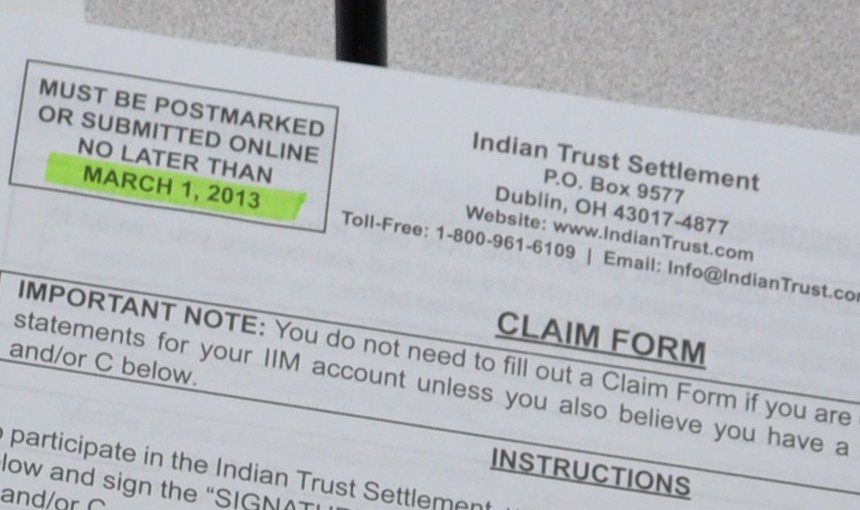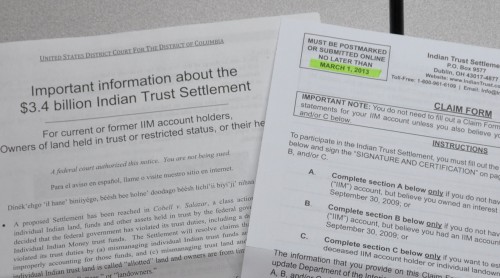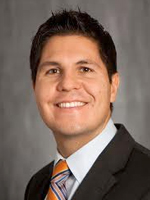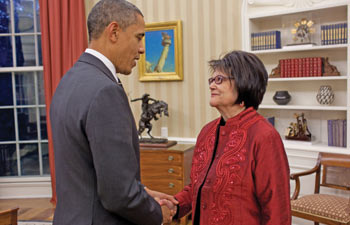More than $12 million transferred as a result of Land Buy-Back Program
Press Release, U.S. Department of the Interior
WASHINGTON, DC – The Department of the Interior today announced it has transferred more than $12 million to the Cobell Education Scholarship Fund, bringing the total amount transferred so far to $17 million. Authorized by the historic Cobell Settlement, and funded in part by the Land Buy-Back Program for Tribal Nations (Buy-Back Program), the Scholarship Fund provides financial assistance through scholarships to American Indian and Alaska Native students wishing to pursue post-secondary and graduate education and training.
“With every transfer to the Scholarship Fund, we are making valuable investments in the training and education that Native students need to succeed in today’s world,” said Interior Deputy Secretary Michael L. Connor. “This program is a lasting tribute to Elouise Cobell, whose vision, leadership and concern for tribal students and their families has created a living legacy for future generations of tribal leaders.”
“The Department is thrilled that the Cobell Scholarship Fund is growing quickly so that Native students can pursue their academic dreams to go to college or graduate school,” said Hilary Tompkins, Solicitor of the Department of the Interior and one of the lead negotiators of the Cobell Settlement. “The expertise, abilities and skills these students gain can help to advance self- determination and shape future leaders in Indian Country.”
The Scholarship Fund is administered by the American Indian Graduate Center (AIGC) located in Albuquerque, N.M. The five-member Cobell Board is responsible for the oversight and supervision of the activities of the fund’s administering organization. Interested applicants should consult the AIGC website at AIGCS.org.
The Cobell Scholarship Fund is overseen by the Cobell Board of Trustees. Alex Pearl, the Chairman of the Cobell Board, said, “This is meant to be a perpetual fund so that Indian students will be able to attend college and receive Cobell Scholarship Funds long after we’re gone. The transfer that the Interior Department is making today will nearly triple the size of the Scholarship Fund precisely when the Board is in the process of deciding what funds can be made available for scholarships for the upcoming academic year beginning this fall.” Pearl went on to say, “The Board is now working with the American Indian Graduate Center to determine the eligibility criteria, but one thing is certain—as required by statute, Cobell Scholarship Funds will be available only to American Indian and Alaska Native students.”
“We at AIGC are eager to establish a working relationship with the Cobell Board of Trustees and to fund applicants for the Cobell Scholarship Program. We are hoping to begin funding with this fall’s term. The provision of a scholarship program in conjunction with the Cobell Settlement was an inspired idea, and we are pleased to have been selected to administer the program,” said Sam Deloria, Director of the American Indian Graduate Center.
Interior makes quarterly transfers to the Scholarship Fund as a result of Buy-Back Program sales, up to a total of $60 million. The amount contributed is based on a formula set forth in the Cobell Settlement that sets aside a certain amount of funding depending on the value of the fractionated interests sold. These contributions do not reduce the amount that an owner will receive for voluntarily consolidating their interests. Thus far the Buy-Back Program has paid more than $360 million to individual landowners and restored the equivalent of almost 570,000 acres of land to tribal governments
The Buy-Back Program was created to implement the land consolidation component of the Cobell Settlement, which provided $1.9 billion to purchase fractionated interests in trust or restricted land from willing landowners. Consolidated interests are transferred to tribal government ownership for uses benefiting the reservation community and tribal members.
Turk Cobell, the President of the Cobell Board, stated that “applications for scholarships for the fall semester will be made available shortly online through the American Indian Graduate Center.”
Buy-Back Program offers are currently pending for fractional interest owners at the Umatilla Indian Reservation (deadline: April 13), Pine Ridge Indian Reservation (deadline: April 20), and Rosebud Indian Reservation (deadline: May 16).
Landowners can contact the Trust Beneficiary Call Center at 888-678-6836 to update their contact information, ask questions about their land or purchase offers, and learn about the financial implications of consolidating land. Individuals can also visit their local Office of the Special Trustee for American Indians (OST) or Bureau of Indian Affairs (BIA) office, or find more information at www.doi.gov/buybackprogram/landowners in order to make informed decisions about their land.







